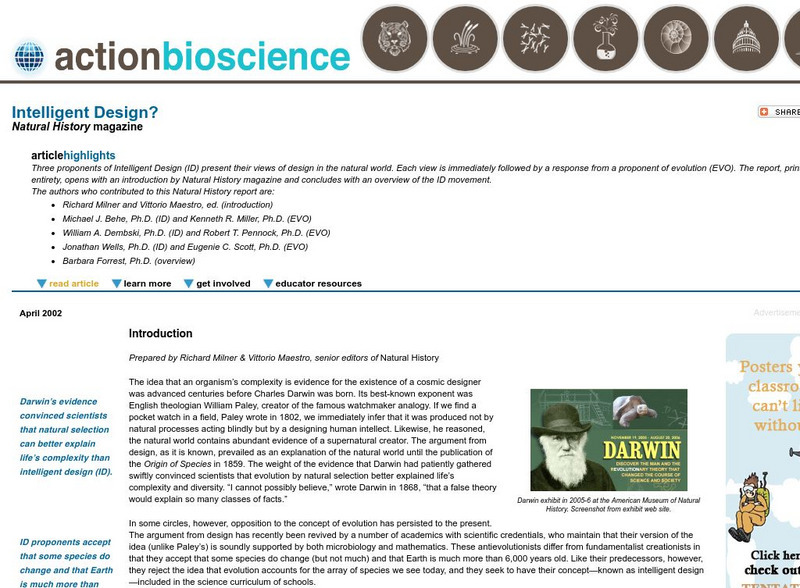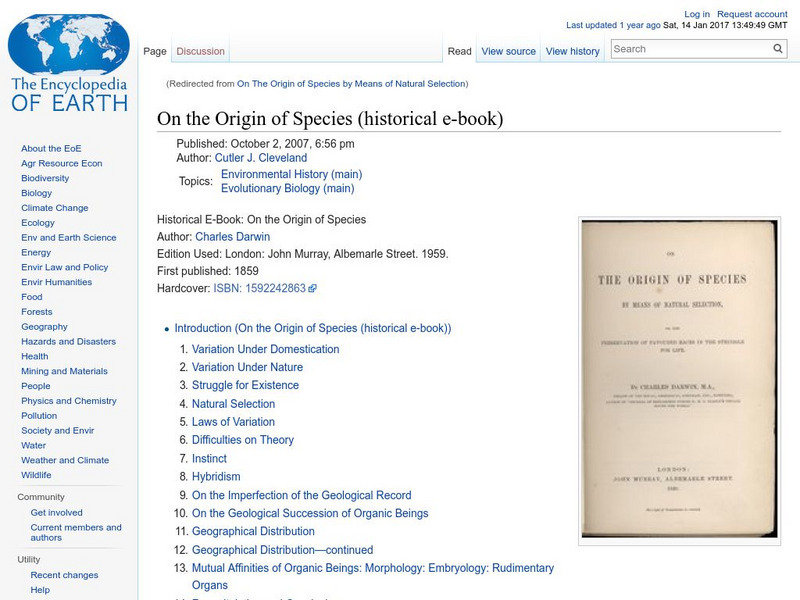Curated OER
FOOTSTEPS IN TIME
Students measure and correlate their foot lengths and body heights, then use this data to estimate height of Laetoli hominids. They use metric measurement and graphing to determine these heights.
Curated OER
WHAT, IF ANYTHING, IS A ZEBRA?
Young scholars read the essay, "What, If Anything, Is a Zebra?" following a teacher made reading guide. They investigate cladistics, shared derived characteristics, with further online research to enhance their study of evolution and...
Curated OER
Comparison of Human and Chimpanzee Chromosomes
Students actively engage in the careful analysis of chromosome banding patterns and identify examples of inversion in homologous chromosomes.
Curated OER
Birds of a Feather Flock to the Web
Students define the term "evolution" and relate it to species adaptation, supporting their ideas with examples. They locate, correctly cite, and briefly review two Web sites with information on finches commonly found in their state or count
Curated OER
Evolution
Students create a timeline on the history of evolution. In this biology lesson, students research their assigned scientist's contribution to evolution theory. They write a three-paragraph analysis about the timeline.
Curated OER
Walking Whales
Eighth graders explore the theory of evolution of whales. In this walking whales instructional activity students study a reading packet, divide into groups and respond to given questions.
Curated OER
Introduction to Biology
Students examine the principles of natural selection and explain how it is the basis of the theory of evolution. For this natural selection lesson students research the web on the theory of evolution.
Curated OER
Becoming Human
In this evolution worksheet, students access a specific website and then answer questions about human evolution based on what they discovered at the website. This worksheet has 19 short answer questions and 3 essay questions.
Curated OER
Evolution
Students investigate the concept of evolution and its implications upon the origin and development of life. They conduct research using a variety of resources while focusing upon cross-over and mutations. The information is used to set...
Curated OER
Evolution
Learners illustrate the results of natural selection by identifying the specific adaptation of an organism that allows the species to survive in that environment. They illustrate the results of natural selection by recognizing examples...
Curated OER
History Theory of Evolution
Students identify fossils. They identify evidence of change over time when given pictures of fossils to determine the proper sequencing. In addition, they determine evolutionary relationships by comparing embryonic structures.
Curated OER
"Making a Good Impression"
Students are shown how fossils are formed and to learn how extinct organisms lived based on their remains and surroundings. They are shown TAKS review problems on the overhead related to evolution and fossil evidence. Students discuss...
Curated OER
Darwin's Theory
Students write an essay about evolution. They summarize Darwin's Theory and discuss its strength and weakness of evolutionary theory. Students discuss the struggle of existence and survival of the fittest. They discuss the evidence of...
Curated OER
A Tree Full of Ancestors
Learners study human evolution and the scientific process. They complete the Origins of Humankind Web activity to become familiar with the hominid species as well as the associated evidence found, in the form of fossils and artifacts.
Curated OER
What Killed the Dinosaurs?
Students demonstrate how scientists use evidence to formulate hypotheses. They write an essay describing the Cretaceous and Paleocene time periods from the point of view of someone living in that time. In addition, they formulate...
Curated OER
Evolution, Genes, and Behavior
Students examine the roles of genes and evolution on behaviors. In groups, they identify the relationships among DNA, genes and chromosomes. They evaluate the different theories of language acquistion and how evolved tendencies interact...
Curated OER
Evolution in Action!
Students use the Internet to complete an interactive simulation about evolution. They follow certain species and discover the process of natural selection. They answer questions to test for comprehension.
Curated OER
Inspired Science
Pupils explore the history of inventions and their difference from discoveries. They create timelines of inventions, demonstrating their connections to each other.
Curated OER
13 Ways to Tell Time Backwards
Students explore different ways geological time can be measured: comparing the time dimensions for each method, the mechanisms of each method, and the materials used.
Curated OER
Why Don't Whales Have Legs?
Students are given a variety of materials and are asked to design a heat loss experiment that results in a reasonable explanation of "Why don't whales have legs?" students work with the theory of natural selection.
George Mason University
Chnm: Between the Wars: The Scopes Trial
Read the fascinating transcript of the proceedings in court when Clarence Darrow called William Jennings Bryan to the stand to expose the weakness in his argument against evolution in the famous Scopes trial.
American Institute of Biological Sciences
Action Bioscience: Intelligent Design?
Immerse yourself in evidence supporting and rejecting the ideas of intelligent design.
American Institute of Biological Sciences
Action Bioscience: Natural Selection: How Evolution Works
An interview with Douglas Futuyma, renowned evolutionary scientist, explaining the theory of natural selection and how it steers toward evolution.
Encyclopedia of Earth
Encyclopedia of Earth: On the Origin of Species (Historical E Book)
The complete original text of On the Origin of Species by Charles Darwin.

























